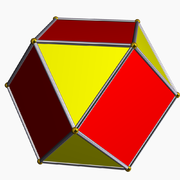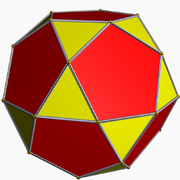- Truncated cuboctahedron
-
Truncated cuboctahedron 
(Click here for rotating model)Type Archimedean solid
Uniform polyhedronElements F = 26, E = 72, V = 48 (χ = 2) Faces by sides 12{4}+8{6}+6{8} Schläfli symbol t0,1,2{4,3} Wythoff symbol 2 3 4 | Coxeter-Dynkin 




Symmetry Oh, [4,3], (*432) Dihedral Angle References U11, C23, W15 Properties Semiregular convex zonohedron 
Colored faces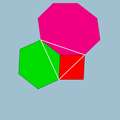
4.6.8
(Vertex figure)
Disdyakis dodecahedron
(dual polyhedron)
NetIn geometry, the truncated cuboctahedron is an Archimedean solid. It has 12 square faces, 8 regular hexagonal faces, 6 regular octagonal faces, 48 vertices and 72 edges. Since each of its faces has point symmetry (equivalently, 180° rotational symmetry), the truncated cuboctahedron is a zonohedron.
Contents
Cartesian coordinates
Orthographic projections 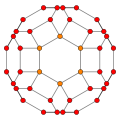
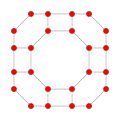
The Cartesian coordinates for the vertices of a truncated cuboctahedron having edge length 2 and centered at the origin are all permutations of:
- (±1, ±(1+√2), ±(1+2√2))
Area and volume
The area A and the volume V of the truncated cuboctahedron of edge length a are:
Vertices
To derive the number of vertices, we note that each vertex is the meeting point of a square, hexagon, and octagon.
- Each of the 12 squares with their 4 vertices contribute 48 vertices because
 .
. - Each of the 8 hexagons with their 6 vertices contribute 48 vertices because
 .
. - Each of the 6 octagons with their 8 vertices contribute 48 vertices because
 .
.
Therefore, there may seem to exist 48 + 48 + 48 = 144 vertices. However, we have over-counted the vertices thrice since a square, hexagon, and octagon meet at each vertex. Consequently, we divide 144 by 3 to correct for our over-counting: 144 / 3 = 48.
Dual
If the original truncated cuboctahedron has edge length 1, its dual disdyakis dodecahedron has edge lengths
 ,
,  and
and  .
.Uniform colorings
There is only one uniform coloring of the faces of this polyhedron, one color for each face type.
A 2-uniform coloring also exists with alternately colored hexagons.
Other names
Alternate interchangeable names are:
- Truncated cuboctahedron (Johannes Kepler)
- Rhombitruncated cuboctahedron (Magnus Wenninger[1])
- Great rhombicuboctahedron (Robert Williams[2])
- Great rhombcuboctahedron (Peter Cromwell[3])
- Omnitruncated cube or cantitruncated cube (Norman Johnson)
The name truncated cuboctahedron, given originally by Johannes Kepler, is a little misleading. If you truncate a cuboctahedron by cutting the corners off, you do not get this uniform figure: some of the faces will be rectangles. However, the resulting figure is topologically equivalent to a truncated cuboctahedron and can always be deformed until the faces are regular.
The alternative name great rhombicuboctahedron refers to the fact that the 12 square faces lie in the same planes as the 12 faces of the rhombic dodecahedron which is dual to the cuboctahedron. Compare to small rhombicuboctahedron.
One unfortunate point of confusion: There is a nonconvex uniform polyhedron by the same name. See nonconvex great rhombicuboctahedron.
See also
- cube
- cuboctahedron
- octahedron
- truncated icosidodecahedron
- Truncated octahedron - truncated tetratetrahedron
Notes
- ^ Wenninger, Magnus (1974), Polyhedron Models, Cambridge University Press, ISBN 978-0-521-09859-5, MR0467493 (Model 15, p. 29)
- ^ Williams, Robert (1979). The Geometrical Foundation of Natural Structure: A Source Book of Design. Dover Publications, Inc. ISBN 0-486-23729-X. (Section 3-9, p. 82)
- ^ Cromwell, P.; Polyhedra, CUP hbk (1997), pbk. (1999). (p. 82)
External links
- Eric W. Weisstein, Great rhombicuboctahedron (Archimedean solid) at MathWorld.
- Richard Klitzing, 3D convex uniform polyhedra, x3x4x - girco
- Editable printable net of a truncated cuboctahedron with interactive 3D view
- The Uniform Polyhedra
- Virtual Reality Polyhedra The Encyclopedia of Polyhedra
- great Rhombicuboctahedron: paper strips for plaiting
Polyhedron navigator Platonic solids (regular) Archimedean solids
(Semiregular/Uniform)truncated tetrahedron · cuboctahedron · truncated cube · truncated octahedron · rhombicuboctahedron · truncated cuboctahedron · snub cube · icosidodecahedron · truncated dodecahedron · truncated icosahedron · rhombicosidodecahedron · truncated icosidodecahedron · snub dodecahedronCatalan solids
(Dual semiregular)triakis tetrahedron · rhombic dodecahedron · triakis octahedron · tetrakis cube · deltoidal icositetrahedron · disdyakis dodecahedron · pentagonal icositetrahedron · rhombic triacontahedron · triakis icosahedron · pentakis dodecahedron · deltoidal hexecontahedron · disdyakis triacontahedron · pentagonal hexecontahedronDihedral regular Dihedral uniform Duals of dihedral uniform Dihedral others Degenerate polyhedra are in italics.Categories:- Uniform polyhedra
- Archimedean solids
- Zonohedra
Wikimedia Foundation. 2010.








